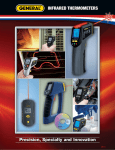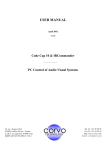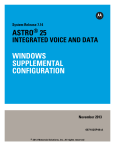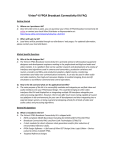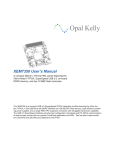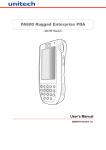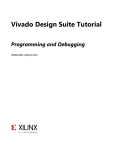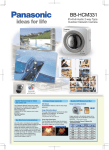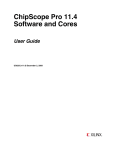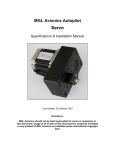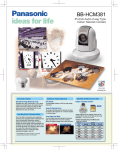Download USER MANUAL IRT
Transcript
USER MANUAL January 2002 IRT-11 & CORLINK Infrared to RS-232 Transcoder 24, rue Jacques Ibert 92300 Levallois-Perret - France S.A.R.L. au capital de 20 000 euros RCS B 440 545 903 corvo TECHNOLOGY Tel. 33 1 47 59 50 05 Fax 33 1 47 59 50 33 http://www.corvo.com [email protected] Contents Introduction.............................................................. 3 System Requirements .............................................. 3 Corlink Installation ................................................. 3 Corlink Configuration & Programming ............... 3 The Programming Matrix....................................... 5 Testing Command Sequences ................................. 6 Data Base Management........................................... 6 The I/R Link............................................................. 6 Operation of the IRT-11.......................................... 7 Trouble Shooting ..................................................... 9 RS-422 Configuration.............................................. 9 Technical Specifications ........................................ 10 Packing List............................................................ 10 2 Introduction The IRT-11 is intended to provide I/R remote control of devices equipped with RS-232 (or RS-422) control ports. Up to 64 commands can be programmed in the IRT-11 using a Windows based PC and the Corlink software. After programming, the IRT-11 is connected to the serial port of the device to be controlled. Commands are sent to the IRT11 with any properly set-up RC-5 I/R remote controller. Each I/R command corresponds to one RS-232 command as defined by the user with the Corlink software. System Requirements 1. 2. 3. 4. 5. 6. 15 MB of free hard drive capacity for program installation. A minimum of 1 MB of hard drive capacity for user data. Windows 9X, Win NT or Win 2000 operating system. A free communications port. A CRT monitor capable of displaying at least 800x600 images. A CPU speed of at least 120 MHz. Corlink Installation The Corlink software is provided on a CDRom, which, in most cases, will auto-load. If auto-load does not occur, execute the Corlink set-up file to start the installation procedure. Follow screen instruction and re-start the PC to finish the procedure. Corlink Configuration & Programming • Open Corlink Choose the serial port of the PC to which you have connected the IRT-11 module with its supplied serial cable. Successful selection of the serial port will cause the Corlink programming screen to appear with the following functions : File - New : Clicking “New” generates a configuration table for a specific machine to be controlled. It should be understood that every device has its own RS-232 communications protocol usually consisting of a sequence of several characters transmitted in accordance with a specific set of transmission parameters such as speed, parity, stop bits and the time interval between characters (or bytes) in the transmission sequence. As you will see below, Corlink allows you to program all these parameters for a specific device into a device configuration which is stored on the hard disk of the PC and, when in active service, down-loaded to the IRT11. The user is invited to provide the following information : 3 - File Name : User-assigned name of the device, such as “Barco 801” - Speed : Baud rate required by the device’s communication protocol - Parity : Parity, if any, of the devices communication protocol - No. Of Stop Bit(s) : The number of stop bits in the devices communications protocol - Time Delay : Allows you to choose from two types of timing intervals between the transmission characters : • Specific : Places a single time delay after the character defined below in the “character Number” box described below. • Global : Places a time delay between all characters, the value of which is defined by the drop-down menu. Setting of this parameter depends on the communications protocol of the device. - Character Number : As explained above, for the case of a specific, one-time delay, this box defines the character which precedes the time delay. - Delay Time : The timing interval between two characters expressed in milliseconds. Thee range of choice is 1 to 20 ms. - Fill-up Value : The user can choose a Hex value which automatically fills all boxes in the programming matrix when a new programming matrix is first loaded. When Corlink is first opened the value is 00 but the user can change it. Care should be taken to avoid choosing a value that has a meaning in the communications protocol. When reading commands on the Corlink receive utility screen, the chosen fill-up character is not displayed to make it easier reading the useful characters. When all parameters have been assigned, click on “save” to save the configuration under the name entered in the “Name” box and to open the programming matrix screen for this device. - Open : • Clicking on “Open” opens a list of *.col files, each corresponding to a device you previously programmed. • Double clicking on the file you wish to open will cause this device’s programming matrix screen to open. 4 • Tools - Parameters : Allows you to return to the parameter setting screen for consultation or modification - Download to IRT-11 : Downloads the contents of the current device’s transmission parameters and command data to be stored in the IRT-11. - Display IRT-11 Output : Displays data transmitted by the IRT-11 when a valid I/R command is received by the IRT-11. This is a test feature allowing the user to confirm that the characters being transmitted by the IRT-11 correspond to the programmed values. Care must be taken to set the transmission parameters to the values used when the device command file was established. Failure to set the transmission parameters will cause mis-operation of the read-out display. The Programming Matrix The columns of the programming matrix are defined as follows : - RC-5 Code : The RC-5 code number which causes the RS-232 sequence on that row of the matrix to be generated. There are 64 rows corresponding to RC-5 codes 00 to 63. In other words, the I/R controller you use must be capable of generating the RC-5 codes actively used in the matrix. Attention must also be given to using the correct RC-5 System Address (discussed below). - Command Name : The user assigned name for a given command code such as “Play” or “Channel 2”. Type the chosen text in the command name cell for each command. - D1 to D10 : These ten columns allow the user to enter the hexadecimal (“Hex”) value of each of the characters in the command sequence. For example, the command “play” might require a sequence of four characters : 05 01 A0 and A1 (Hex). The matrix would be written as follows : RC-5 Code 0 Command Name Play D1 D2 D3 D4 D5 D6 ….. 05 01 A0 A1 00 00 …… It should be noted that the maximum number of characters in a command sequence is ten. If the command has less than 10 characters (most likely) the unused cell entries should contain the user defined fill-up character discussed above. 5 - Repetition : Depending on the type of command being transmitted, it may be necessary to transmit it many times (as long as the I/R remote command remains active) or to transmit the command only once even if the I/R remote command remains active. For example, if you were sending a single digit number such as “3” you wouldn’t want it to become “33333” so in this case the repetition function should be toggled off. On the other hand, if the command you were sending incremented a potentiometer each time the command was received, repetition is desirable and would be toggled on. Testing Command Sequences When a command sequence has been programmed it can be tested immediately without the IRT-11. Proceed as follows : - Connect the serial port of the PC to the serial port of the device being controlled. - Start Corlink and select the device file corresponding to the device being controlled. - Select the command you wish to test by clicking on its row in the programming matrix to hi-lite it. - Double right click on the selected row which causes that command to be transmitted (the message “Transmit” appears). If this operation fails to send the command properly, you must review your transmission parameters, hex values and timing to correct the problem. Data Base Management Each programming matrix can be assigned its own name and saved to disk for future use with other IRT-11 modules. The configurations can be modified and/or renamed at any time allowing several command programs for the same device (for example for different user access levels). The I/R Link As previously stated, a valid RC-5 I/R command received by the IRT-11 is what causes an RS-232 command to be transmitted. Many intelligent remote controls already contain all the RC-5 codes. If this is not the case, Corvo has available a universal RC-5 programming remote, TXIR-RC5, capable of producing all codes and all system addresses. 6 The RC-5 code format has 32 system addresses : 00 to 31. System addresses allow discrimination between identical I/R codes so several devices using the same codes can cohabitate the same I/R environment. The IRT-11 can be set with two DIP switches to select one of 4 different system addresses, which are 24, 25, 26, 27. The factory setting is 25. Other values require setting the DIP switches as follows : RC5 ADR 24 25 26 27 SW A0 SW A1 On Off On Off On On Off Off Other RC-5 addresses can be supplied on demand. It should be noted that the red I/R receive LED on the front panel of the IRT-11 is system address-sensitive; It will only be active if the I/R code received is a valid RC-5 code containing the correct address. If for any reason it is preferred to input wired I/R to the IRT-11, such as from a master control console or a remote I/R relay receiver, this is catered to by the 3-pin connector on the rear panel of the IRT-11. Be very careful to adhere to the wiring indications for each of the 3 pins. The maximum 12Vdc external load to be supplied by the IRT-11 is 50mA. Operation of the IRT-11 Once thee device commands have been programmed into the PC using Corlink and then down-loaded to the IRT-11, the PC is no longer necessary and the IRT-11 is ready to operate. Connect 12Vdc power and the serial cable provided from the IRT-11 to the RS232 serial port of the device. Illuminate the IRT-11 with a valid RC-5 I/R command (corresponding to the RS-232 command you wish to execute). The red I/R receive LED on the front panel should flash when the I/R transmitter is active. The red RS-232 transmit LED on the rear panel should also flash briefly during the transmission. The chosen command should be executed by the device under control. Below are troubleshooting suggestions in case of problems : 7 corvo corvo 8 Trouble Shooting Problem Cause & Solution - Red I/R led fails to blink while sending • I/R transmitter is not sending RC-5 an I/R command. codes at the correct RC-5 system address • The IRT-11 receiver is blocked by other I/R sources such as sunlight or neon lights. - I/R transmissions are properly received • but no RS-232 transmission occurs. • - I/R reception and RS-232 transmission • seem to be functioning but commands are not executed properly • The RC-5 I/R codes being received are of the right address but do not correspond to commands programmed with Corlink For non-repetitive commands, the RS232 transmit LED only blinks briefly so it could be missed if not carefully observed. Review the device manufacturer’s protocol definition carefully to look for errors in your Corlink programming There is no communication between the IRT-11 and the device due to transmission parameter or connecting cable problems. RS-422 Configuration If the required serial interface is RS-422 instead of RS-232, an optional plug-in module (Corvo Reference No. IRT-114) for the IRT-11 will transform the RS-232 interface to RS-422. Installation instructions are supplied with the RS-422 I/R module. Operation of the IRT-11 and programming with Corlink are unchanged. 9 Technical Specifications · RS-232 Commands : · Characters per command : · Transmission speed : · Output Cable : · Power requirements : · Case Size (MM) : · Mass : · Operating Temperature Range : · Storage Temperature Range : 64 Maximum 10 Maximum 33KB/s Maximum RJ12 to SubD9 (supplied) 12Vdc/30mA (PS12-130 not supplied) 150x100x31 (5.9x3.9x1.2’’) 214 Grs (7.5Oz) 0 to 40°C (32 to 104°F) -20 to 60°C (-4 to 140°F) Packing List - IRT-11 Module - Serial Communications Cable - 12V/130mA regulated power supply (Europe Only) - Corlink software on CDRom - User Manual (on CDRom in French & English) 10











